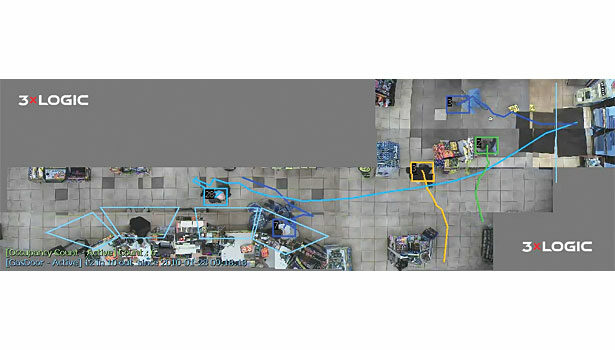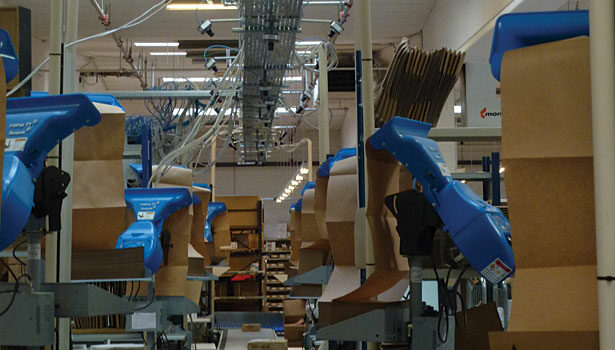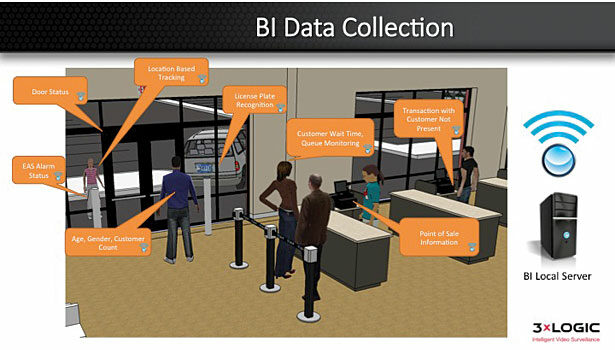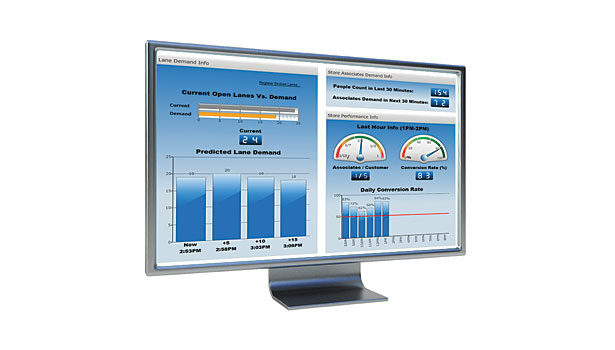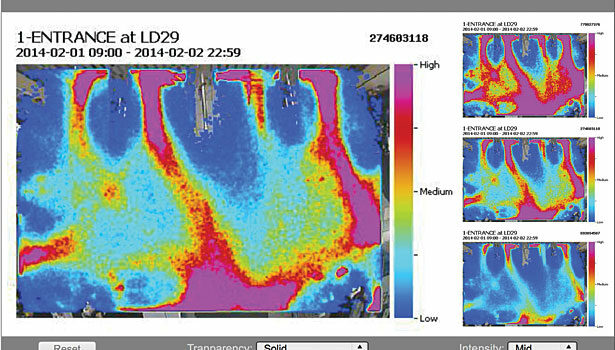The scope of video surveillance-based solutions now extends beyond just security, which presents a new business opportunity for systems integrators. Sophisticated business customers — particularly retailers with multiple outlets — are leveraging video surveillance equipment to support their marketing and merchandising and to enhance operations by counting customers, tracking how long customers spend in different parts of a store and matching video with information from point-of-sale systems to gain business insight. Applications such as these are known as “business intelligence” and although business intelligence is somewhat of a niche market today, it is an area that is growing fast and one that security integrators may want to consider pursuing.
Integrators are taking many different approaches to business intelligence. At one end of the spectrum are nationwide integrators that undertake considerable development work to provide customers with highly customized applications. At the other end are smaller integrators who are finding that business intelligence doesn’t have to be complicated; it just has to be approached with a creative mind.
Programmers Back Tyco Offerings
Boca Raton, Fla.-based Tyco Integrated Security is a sophisticated nationwide security integrator with numerous retail chains among its accounts. One application that is popular with retail chains is the “heat map,” observes Jay Hauhn, chief technology officer for Tyco Integrated Security. In this application, video cameras are used to collect information about how many customers come into a retail outlet and how long they spend at various locations within the outlet. This information then is used to generate color-coded floor plans showing the highest traffic areas, enabling the retailer to better determine the best location for various types of merchandise.
Recently Tyco Integrated Security customers have been paying a lot of attention to metadata, Hauhn says. Metadata, he explains, is data about data. “We’re looking at video to get intelligence,” Hauhn explains. “We’re not storing video, but data about video. We’re recording data that says a person stopped at x and y coordinates, how long the person stopped and where the person went next. We may keep one frame of video. The real value is in the metadata.”
Tyco Retailer Solutions and Tyco Security Products have product development teams whose responsibilities include developing business intelligence applications for key customers.
“Forward-looking companies are usually receptive to piloting new solutions,” Hauhn says. Pilots usually last one to three months and applications with successful pilots may be pitched to a broad range of accounts. Hauhn adds, though, that each application may need some level of customization to meet the needs of specific customers.
DTT Develops ‘Scream’
Los Angeles- and Las Vegas-based integrator DTT Surveillance develops its own business intelligence applications. The company’s offerings can be tailored to the needs of specific customers using programmable options.
One business intelligence application that DTT recently developed carries the brand “Scream” and targets restaurants, including fast-food chains, and other retailers, says DTT Surveillance President and CEO, Sam Naficy. To support this application, retail outlets display signs inviting customers to send text messages to the manager if they have a complaint or compliment. By integrating the application with video, DTT gives management the ability to see what was happening in the retail outlet at the time the text was sent, often enabling management to address the situation while the customer is still on site.
Retailers also can mine the data collected through the text messages to help create targeted promotions. For example, anyone who sent a text message about a seasonal food item could receive a text message the next time that item is back on the menu.
A Specialty for Applied Video
San Francisco-based integrator Applied Video Solutions was founded in 2002 with the goal of specializing in business intelligence. The company occasionally hires programmers on a contract basis to develop applications, but also works closely with developers of point-of-sale systems and video management systems and often is able to persuade those partners to develop a specific application, explains Applied Video Solutions CEO, Dmitri Shimolin.
A population application is to use video cameras to capture information about the number of people who enter a retail outlet and compare that with the number of transactions from that outlet. Those results then are compared with the same measurements from other outlets, enabling Applied Video’s retail accounts to gain substantial insight about shrinkage, inadequate staffing, and the like on an outlet-by-outlet basis.
Integrated Security Leverages Vendor Offerings
Not all integrators have on-staff programmers, but that doesn’t mean they can’t offer business intelligence solutions.
Video analytics software, video management systems, and video recorders from several manufacturers provide business intelligence functionality. Some video cameras also have some basic analytic capability built in. Such equipment becomes more powerful when it is integrated with point-of-sale systems. Some providers of such equipment have worked with key point-of-sale system vendors to integrate the systems.
“A custom driver is created by the video management software company that integrates with software in the point-of-sale terminal and allows us to capture data,” explains Aaron Anderson, product manager for Indianapolis-based Infinias, provider of the DigiOp video management system. “The video analytics determines how to present the data.”
One company that has been able to make business intelligence system sales to key accounts by using products available from equipment and software suppliers is Meridian, Idaho-based Integrated Security Resources. Among its customers is a major wireless carrier, which uses business analytics in its retail outlets to gauge traffic flow and to gauge the success of marketing efforts. As Integrated Security’s Sales and Project Manager, Darren Braden, explains, Integrated Security Resources also has integrated access control systems with business intelligence.
Pro-Tec Uses Creative Thinking
Business intelligence systems do not necessarily have to use analytics, as the experiences of Minneapolis-based Pro-Tec Design illustrate. As Pro-Tec Design’s Director of Sales and Marketing, Tim Ferrian, describes, the company has sold video systems that are used to monitor manufacturing processes — an application that differs from traditional video surveillance systems primarily in where cameras are placed.
Recently, Pro-Tec also picked up some business from the public works department of a local municipality after the traffic control unit of the same municipality installed cameras for traffic control purposes. Ferrian’s contact in public works showed the traffic control system to him and Ferrian suggested public works also use the cameras, but for a different purpose — to see where snow was piled so high at intersections that drivers had trouble seeing around it. Previously, public works sent workers out with snow plows to find such intersections and move the snow. However, thanks to a new flat panel monitor installed by Pro-Tec and connected to the traffic control video system, public works now can identify intersections that need plowing in advance, saving time and resources.
Pro-Tec also is preparing for the possibility of selling video analytics in the future by taking care to install video cameras for any new accounts in a manner that would be conducive to having analytics added at a later time. Such considerations figure into how cameras are placed, Ferrian explained.
Advice for Newbies
Those involved in this business offer a range of business and technology advice for other integrators making the move into business intelligence. On the business side, they stress the importance of showing customers how they can get a return on their investment.
“You have to focus on tangible ROI,” comments Jim Malafronte, vice president for the retail practice at Melville, N.Y.-based manufacturer, Verint Video and Situation Intelligence Solutions. ROI can be generated in four ways, Malafronte notes. These include increasing revenues, reducing costs, increasing customer engagement and improving margins.
Ferrian says he always tries to quantify the potential benefits of business analytics for potential customers. When he sold the flat screen installation to the public works department, for example, he asked the customer how many man-hours employees spent driving around looking for traffic intersections requiring plowing. Then, with the customer’s help, he estimated the potential time savings and the value of that time to the department to come up with an estimated dollar savings. By comparing that with the cost of the installation, Ferrian was able to arrive at an estimated — and attractive — ROI by measuring how long it would take the system to pay for itself.
Another advantage of this approach is that Ferrian’s contacts often have to gain approval for expenditures from higher authorities within their organizations and, as Ferrian explains, “then they’re the salesman” as they seek purchase approval from the finance director or other authorities.
Some business customers are quite savvy about the possibilities of business analytics and will initiate the sales process. When that occurs, the first place they look may be at the integrator that installed whatever existing video surveillance system the company may have. In that situation, Ferrian believes it is not difficult to make the sale.
Systems integrators should do their homework before talking to a potential client about business intelligence, however. Some video management system vendors offer extensive training on their products that can be very helpful in preparing integrators to sell and install the products. Integrators should recognize, though, that some providers of video analytics sell only to qualified dealers.
“We need to ensure that we don’t over saturate the market,” comments Charlie Erickson, vice president of product engineering for Broomfield, Colo.-based video analytic supplier, 3x Logic.
Experts from video management companies may be willing to accompany security integrator salespeople on key sales calls and integrators should take advantage of that, advises Erickson.
Security integrators also should recognize that a limited pilot program is a good first step for customers wanting to implement video analytics. Systems integrators will want to stay closely involved throughout that process, Malafronte advises.
Integrators should offer ongoing maintenance and support for business intelligence systems, eliminating the need for customers to concern themselves with that and generating recurring monthly revenue for the integrator. Such agreements may include software updates and hardware support. Integrators also may offer cloud-based analytics and storage, minimizing the capital investment the customer must make to use business intelligence functionality.
Some systems integrators even may handle some of the responsibilities of reviewing results from analytic systems and making business recommendations based on those reviews. However, integrators do not necessarily have to handle the latter function themselves. Applied Video, for example, has relationships with consulting firms that can handle that responsibility for clients — and both the consulting firm and Applied Video have the opportunity to share in the RMR.
Integrators should consider talking about business intelligence whenever they are pitching video surveillance to customers, sources say. In addition to boosting the average revenue per sale, adding business intelligence can help customers find the budget to fund the installation of video equipment.
“By getting beyond the camera as a security solution, you get budget money from marketing and financial teams and now others have a vested interest in the camera being in place,” observes Tony Sorrentino, president of the security division at Greenville, S.C.-based equipment distributor ScanSource Security.
Shimolin offers one other tip for integrators wanting to sell more business intelligence. “Commit to a vertical market,” he advises. “To be successful you have to immerse yourself in the needs of that vertical industry.”
Technology Tips
How integrators handle the sales process also can impact their long-term success from a technology standpoint, several sources note. Some customers may have inflated ideas about the capabilities of video analytics; it is important for salespeople to set realistic expectations.
Even if a system will not do exactly what a customer wants it to do, it may not be a deal breaker, Erickson advises. He cites the example of a coffee shop chain that wanted to make sure that coffee was made every half hour so that customers always get a fresh cup. 3x Logic specialists explained that it might not be possible to confirm specifically that it was an employee who made the fresh coffee, but that the system would be able to detect when someone (most likely an employee) made coffee.
Erickson notes that systems designed to count customers do not need to be perfect in most cases. “You’re looking for a trend; you’re not trying to protect the White House,” he quips. “If you have 90 percent accuracy, it gives you trends.”
Some additional advice: Don’t rely on camera defaults, says Wendi Burke, director of marketing at IQinVision, San Juan Capistrano, Calif. Technicians may have to make multiple adjustments to ensure that a camera is capturing the images — and ultimately the information — that customers are seeking.
Be sure camera resolution is adequate for the task, comments Scott Schafer, executive vice president, Arecont Vision, located in Glendale, Calif. He notes that companies such as Arecont Vision offer training and resource materials to assist integrators with that process. “When we do training, we tell them if they want to identify a face, they need to have this many pixels per meter,” he explains.
In addition, avoid dynamic lighting, Braden cautions. Changes in lighting can affect the accuracy of video analytic systems, he says.
6 Business Intelligence Applications
Security integrators and their suppliers shared a wide variety of ways that video surveillance can be used to support business intelligence. Some of those applications are:
- Supporting vendor product placement. Retailers often charge suppliers for product placement on the end-cap displays in store aisles. By counting people and measuring “dwell time,” or how long people spend at the end cap, retailers can demonstrate the effectiveness of end cap merchandising, says Gregg Oxfeld, senior national retail account manager for Indianapolis-based security integrator Stanley Security Solutions.
- Virtual loading-dock oversight. One business customer used to have a manager stand at the loading dock to count boxes. The manager now can do so without leaving his or her office, observes Tony Sorrentino of ScanSource Security.
- Controlling employee fraud. One of the greatest benefits a retailer can get by logically connecting video surveillance to a point-of-sale system is the ability to better control employee fraud. When the systems are interconnected, an alert can be generated if a return is made without a customer present. Typically, such systems generate a very favorable ROI, comments Charlie Erickson of 3xLogic.
- Queue management. A business intelligence application that is highly attractive to many accounts is the ability to determine when the number of people in line exceeds a certain threshold. The ability to manage this predictively is a hot application, observes Jim Malafronte of Verint.
- Portion control and plating consistency. Applied Video developed an application for restaurants that enables a video camera to record a single image of every plate the company serves. The chef can easily review the images to help ensure that portions and plating are consistent on a dish-by-dish basis.
- Lease enforcement. This application uses video surveillance equipment to determine whether there are more people living in an apartment than specified in the tenant’s lease, explains Wendi Burke of IQinVision.
Common Language
Like any technology specialty, business intelligence uses some unique jargon. A few terms that systems integrators should know include:
- Corral — a noun used to describe the people waiting in line to check out at a retail outlet who have not yet reached the cash register
- Dwell time — the amount of time that a customer spends in a specific location in a retail outlet
- Heat map — a floor plan graphic that is color-coded to show areas where customers spent the greatest and least amount of time
